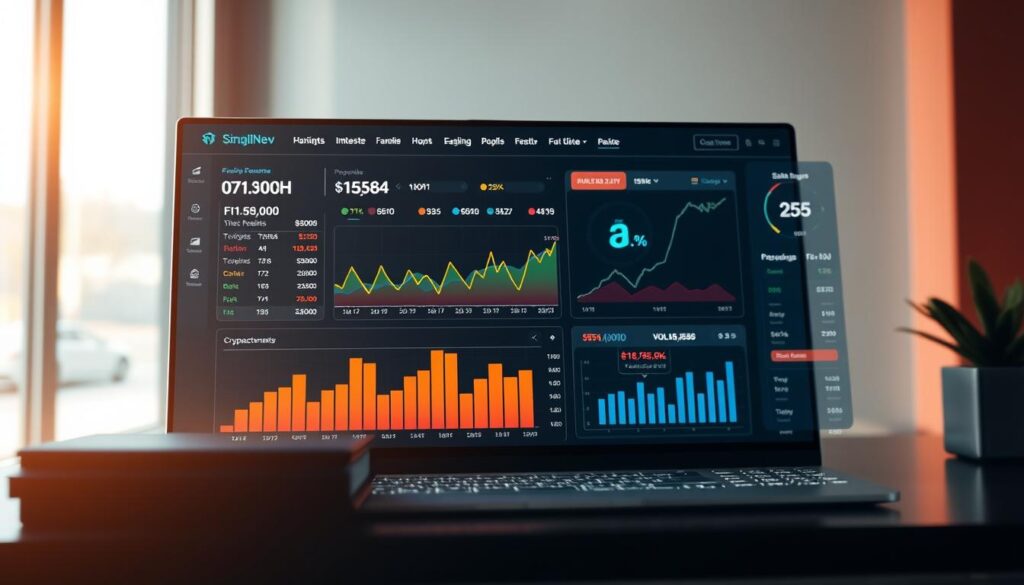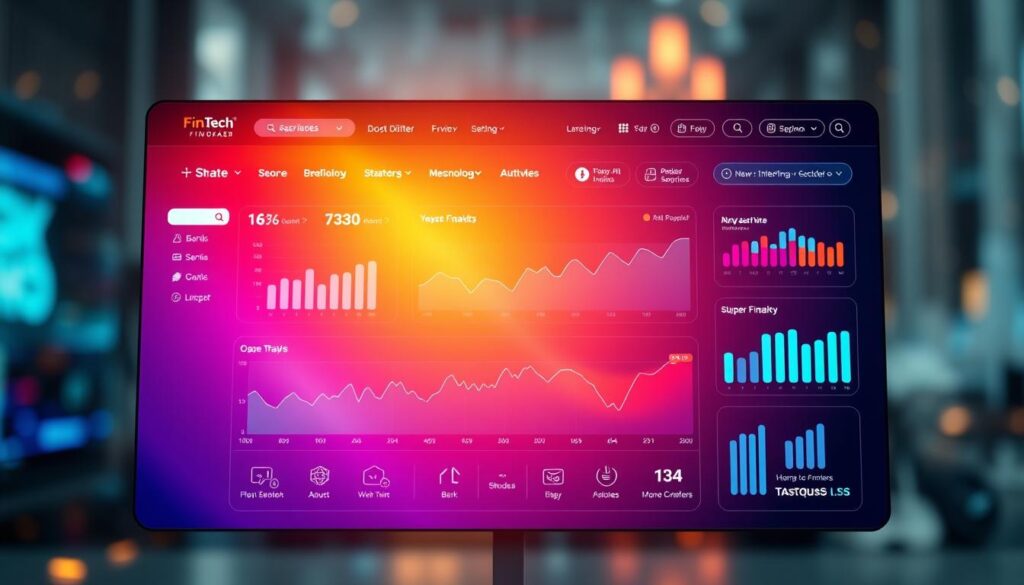The path to financial freedom and independence can be daunting, but with the right tools and resources, it becomes an empowering journey. Revolution Money Exchange is a trusted hub dedicated to unlocking the insights, tools, and knowledge you need to take control of your financial future. Explore the cutting-edge designs and innovative features of the best fintech websites that are redefining the industry landscape.
Key Takeaways
- Fintech websites play a crucial role in establishing trust and credibility in the financial technology industry.
- Modern fintech web design incorporates elements such as animations, microinteractions, data visualization, and mobile-first design to create an immersive user experience.
- Personalization, dark mode, and product UI illustrations are trending features that enhance the overall user experience on fintech websites.
- Engaging visuals, clear calls to action, user-friendly navigation, and strong value propositions are key elements of top-performing fintech websites.
- Mobile optimization is essential for fintech firms due to the increasing use of mobile devices, and fintech websites must balance aesthetic appeal with functionality.
Understanding Modern Fintech Web Design Trends
The world of fintech is rapidly evolving, and the web design trends that define successful fintech websites are equally dynamic. From captivating animations to mobile-first approaches, modern fintech websites are pushing the boundaries of user engagement and visual appeal.
Animations and Interactive Elements
Animations bring fintech websites to life, adding a layer of interactivity that enhances user engagement. Leading fintech platforms like Stripe, CashApp, and Marqeta seamlessly integrate vibrant mesh gradients, fluorescent color schemes, and breathtaking card animations to create a truly immersive digital experience.
Mobile-First Design Approach
With the majority of fintech users accessing websites via their smartphones, a mobile-first design approach is crucial. Fintech giants like SoFi and Revolut have mastered this trend, incorporating responsive layouts, intuitive navigation, and optimized content to ensure a seamless user experience across all devices.
Dark Mode and Visual Appeal
The rise of dark mode has transformed the aesthetic of fintech websites, offering a sleek and futuristic look that reduces eye strain while making colorful imagery stand out. Companies like Meow and Justworks have embraced this trend, complementing their dark mode designs with playful shapes, pastel gradients, and high-quality product illustrations to create a visually striking presence.
These modern design trends have become essential ingredients in crafting successful fintech websites that cater to the preferences and technology use of today’s digital-savvy consumers. By blending animations, mobile optimization, and visually appealing aesthetics, leading fintech platforms are redefining the user experience and setting new standards for the industry.
Essential Elements of Successful Fintech Site Design
Crafting a captivating and user-centric fintech website is crucial for establishing a strong online presence in the ever-evolving digital landscape. Successful fintech website design encompasses a harmonious blend of key elements that collectively create a trustworthy and efficient user experience.
One vital aspect is intuitive navigation that guides visitors through the website seamlessly. By optimizing the information architecture and implementing clear call-to-action (CTA) placements, fintech companies can ensure their customers easily access the resources and services they seek.
Equally important is visual clarity – the strategic use of design elements, typography, and color palettes to enhance the overall aesthetic appeal and brand consistency. This not only elevates the best fintech website experience but also reinforces the company’s credibility and professionalism.
Robust security features are a non-negotiable in the fintech industry, where user data protection is paramount. Prominently displaying security certifications, encryption protocols, and authentication methods can instill a sense of trust and safety, crucial for facilitating seamless and secure transactions.
Lastly, engaging content that speaks directly to the target audience’s needs and interests is essential. By crafting informative, educational, and visually appealing content, fintech companies can establish themselves as thought leaders, nurture customer relationships, and drive valuable conversions.
These core elements, when harmoniously integrated, create a fintech website that not only captivates users but also delivers tangible business results through enhanced search engine visibility, lead generation, and customer loyalty.
| Key Element | Importance | Best Practices |
|---|---|---|
| Intuitive Navigation | Facilitates seamless user experience and information access |
|
| Visual Clarity | Enhances brand consistency and professional image |
|
| Security Features | Builds user trust and ensures data protection |
|
| Engaging Content | Establishes thought leadership and nurtures customer relationships |
|
By prioritizing these essential elements, fintech companies can create a best fintech website that not only captivates users but also drives tangible business results through enhanced search engine visibility, lead generation, and customer loyalty.

Top Payment Processing Platform Websites
In the dynamic fintech landscape, leading payment processing platforms have innovated their web designs to captivate users and effectively convey their unique brand identities. Among the standouts are Stripe, CashApp, and Marqeta, each showcasing distinct design approaches that elevate the user experience.
Stripe’s Dynamic Design Features
Stripe’s fintech site boasts a vibrant, mesh-gradient-infused aesthetic, accompanied by dynamic motion graphics and engaging microinteractions. The platform’s visual language effectively communicates its forward-thinking and technologically advanced nature, drawing users into an immersive digital experience.
CashApp’s Innovative Approach
CashApp, the popular peer-to-peer payment app, stands out with its unique fluorescent color scheme and 3D holographic design elements. Coupled with playful illustrations, this innovative approach sets CashApp apart, creating a visually striking and memorable user interface that resonates with its target audience.
Marqeta’s User Experience Excellence
Marqeta, a leading card issuing and processing platform, excels in its user experience design. The website features captivating credit card animations, isometric product illustrations, and an intuitive menu navigation system, ensuring seamless interactions and a strong brand identity for Marqeta’s fintech offerings.
| Platform | FAB Score | Monthly Website Visits | Market Cap | Employees |
|---|---|---|---|---|
| Stripe | 12,240 | 70 million | N/A | 8,020 |
| Block/Square | 5,050 | 45 million | N/A | 13,000 |
| Adyen | 4,530 | 35.1 million | $39 billion | 4,230 |
These leading fintech sites and fintech web designs showcase the industry’s commitment to delivering innovative, user-centric experiences that resonate with modern fintech consumers.
Digital Banking Platforms Leading the Way
In the dynamic fintech landscape, digital banking platforms are at the forefront of innovation, reshaping the financial services industry. Platforms like SoFi, Revolut, and Meow exemplify the cutting-edge of fintech web design, seamlessly blending aesthetics and functionality to deliver exceptional user experiences.
SoFi’s website stands out with its captivating hero section, soothing color palette, and compelling copy that resonates with its tech-savvy audience. Revolut, on the other hand, incorporates interactive customer testimonials and bold, vibrant colors to build trust and engagement. Meow, a rising digital banking player, showcases high-quality product illustrations, pastel gradients, and a dynamic trust bar, all designed to instill confidence in its users.
These digital banking platforms are redefining the fintech landscape by focusing on building trust, providing clear and comprehensive information, and creating engaging user experiences. As the demand for digital financial services continues to grow, with digital payments projected to reach nearly 4.8 billion users by 2028, the importance of exceptional fintech website and fintech web design cannot be overstated.
“Fintech firms like Revolut and Monzo are targeting younger, tech-savvy audiences with features like instant transaction notifications and cryptocurrency trading.”
Established banks are also rapidly adopting digital solutions to keep pace with the competitive market, recognizing the shift towards seamless, accessible, and personalized financial services. Neobanks, such as Starling Bank and N26, are further disrupting the industry with their mobile-first, branchless banking models, delivering comprehensive services through user-friendly mobile applications.
As the fintech sector continues to evolve, digital banking platforms that prioritize exceptional user experiences, robust security features, and innovative technologies will emerge as the leaders in this dynamic and rapidly growing industry.

Trust-Building Elements in Fintech Websites
In the rapidly evolving fintech landscape, establishing trust is paramount. Fintech services handle vast amounts of personal and financial information daily, making security and transparency critical for building user confidence. Successful fintech websites integrate strategic design elements to foster trust and demonstrate their commitment to safeguarding customer data.
Security Features Display
Prominent display of security features, such as SSL/TLS encryption, two-factor authentication, and data privacy policies, reassures users that their sensitive information is protected. Fintech sites like Stripe and Marqeta prominently showcase these trust-building elements, instilling a sense of safety and reliability.
Customer Testimonial Integration
Integrating authentic customer testimonials and reviews on fintech websites humanizes the brand and provides social proof of its trustworthiness. By showcasing real-life success stories and positive user experiences, fintech platforms like CashApp can build credibility and foster a sense of community.
Professional Certifications Showcase
Highlighting professional certifications, industry affiliations, and regulatory compliance on fintech websites can further establish credibility. This visual cue assures users that the platform adheres to industry standards and best practices, reinforcing the fintech site’s commitment to security and reliability.
By strategically incorporating these trust-building elements, fintech websites can cultivate a sense of confidence and transparency, empowering users to engage with their services with peace of mind. This holistic approach to design and user experience is crucial for fintech sites aiming to become the best fintech website in the eyes of their target audience.
“Transparency and clear communication in fintech services can empower users by explaining terms, fees, risks, and simplifying complexities.”
Investment and Trading Platform Designs
In the dynamic world of fintech, investment and trading platforms have emerged as a standout segment, showcasing innovative web designs that captivate users. Two such platforms, Robinhood and Wealthfront, have garnered attention for their visually striking and user-friendly interfaces.
Robinhood, the pioneering commission-free trading app, features an out-of-the-box design with a bold color palette and unique scrolling effects. The platform’s website seamlessly blends aesthetics and functionality, making complex financial information accessible to both novice and experienced investors. Robinhood’s design approach has earned it 107 likes from the design community, reflecting its ability to engage and inform its target audience.
On the other hand, Wealthfront’s website presents a different take on fintech web design. Although information-rich, the platform’s interface remains well-organized and visually appealing, with effective use of graphics and typography. Wealthfront’s design has resonated with its audience, garnering 499 likes, the highest among the showcased fintech website designs. This design excellence communicates the platform’s expertise and trustworthiness, essential in the investment management space.
These investment and trading platform designs exemplify the fintech industry’s commitment to creating user-centric experiences. By striking a balance between aesthetics, functionality, and financial information, Robinhood and Wealthfront have set new standards for fintech web design, captivating both seasoned investors and those new to the world of investing.
| Platform | Likes | Design Focus |
|---|---|---|
| Robinhood | 107 | Bold color palette, unique scrolling effects |
| Wealthfront | 499 | Well-organized, visually appealing, effective use of graphics and typography |
“Fintech web design must strike a delicate balance between aesthetics, functionality, and financial information to captivate both novice and experienced investors.”
User Experience Best Practices for Fintech Sites
Optimizing the user experience (UX) is crucial for the success of fintech websites and fintech web design. By implementing best practices, fintech companies can create seamless, intuitive, and engaging digital experiences that build trust and drive user engagement.
Navigation Optimization
Streamlined navigation is essential for fintech websites. Examples like Paystand’s mega menu and Clyde’s card-based organization demonstrate effective navigation structures that help users easily find the information they need. Clear and intuitive information architecture enhances the overall user experience.
Content Organization
Well-structured and organized content is key for fintech web design. By prioritizing user-centric content hierarchy and presentation, fintech sites can ensure that visitors can quickly access relevant information. Techniques like progressive disclosure and modular design help create a clean and focused user interface.
Call-to-Action Placement
Strategic placement of clear and compelling call-to-action (CTA) buttons is crucial for driving user engagement and conversions on fintech websites. Rocket’s website, for instance, showcases effective CTA integration, encouraging users to take desired actions such as sign up, invest, or make a payment.
By incorporating these user experience best practices, fintech companies can create digital platforms that are not only visually appealing but also highly functional, intuitive, and trustworthy. This helps to enhance customer satisfaction, increase user retention, and ultimately drive business success in the competitive fintech landscape.
Visual Branding in Fintech Web Design
Visual branding plays a crucial role in the success of fintech websites, as it helps companies stand out in the crowded digital landscape and build trust with their audience. Fintech brands like Binance and Credit Karma exemplify the power of effective visual branding.
Binance, a leading cryptocurrency exchange, utilizes a clean and stark design with harmonious elements, creating a sense of reliability and security. In contrast, Credit Karma, a personal finance platform, employs a vibrant color palette of pastel hues against contrasting black fonts, conveying a modern and approachable aesthetic. Consistent visual branding across all pages, including logos, color schemes, and typography, is essential for creating a cohesive user experience and reinforcing brand identity.
Investing in high-quality visual design is paramount for fintech companies seeking to establish a strong online presence and foster customer loyalty. Effective visual branding not only helps fintech sites stand out in a competitive market but also builds recognition and trust among users, which is crucial in the financial industry. By aligning their visual identity with their unique value propositions, fintech brands can differentiate themselves and effectively communicate their commitment to reliability, security, and transparency.
FAQ
What are the key elements of modern fintech web design?
How do animations and interactive elements enhance fintech websites?
Why is mobile-first design crucial for fintech websites?
How does dark mode benefit fintech website design?
What are the essential elements of successful fintech website design?
How do leading payment processing platforms showcase innovative fintech web design?
What design approaches do digital banking websites use to enhance user experience?
What trust-building elements are crucial for fintech websites?
How do investment and trading platform websites showcase innovative fintech web design?
What user experience best practices are important for fintech websites?
How do successful fintech companies leverage visual branding in their web design?
Source Links
- Fintech Website Design
- 30 Best Fintech Website Design Examples | Caffeine Marketing
- 20 Best Fintech Website Designs I CyberOptik
- 24 Best Fintech Website Design Examples
- Fintech Website Design: Trends & Examples
- Top Fintech Website Design Examples for Inspiration
- The 10 Must-Haves For a Successful Fintech Product Website | Pixels and Sense
- Top 9 Online Digital Payment Processors for Small Businesses (SMB)
- 10 Best Payment Gateways
- Council Post: The Rise Of Digital Banking: A Paradigm Shift In Fintech
- Digital Banking vs. Fintech: A Comparative Guide
- Mastering Fintech UX: Boosting Trust and User-Friendly Experiences
- Web and mobile app development company
- Trading Platform designs, themes, templates and downloadable graphic elements on Dribbble
- Luma Financial Technologies | Fintech: Cap-Alts, Structured Products, Annuities
- Platform that integrates both robo-advisor and trading features | Shakuro
- Fintech UX Design: Challenges and Best Practices
- Fintech UX Best Practices for Enhanced Customer Experience
- Fintech UX Design: Complete Guide
- Fintech Branding: Key Strategies an Examples | Ramotion
- Fintech Branding designs, themes, templates and downloadable graphic elements on Dribbble
- Examples of visually appealing fintech brands



